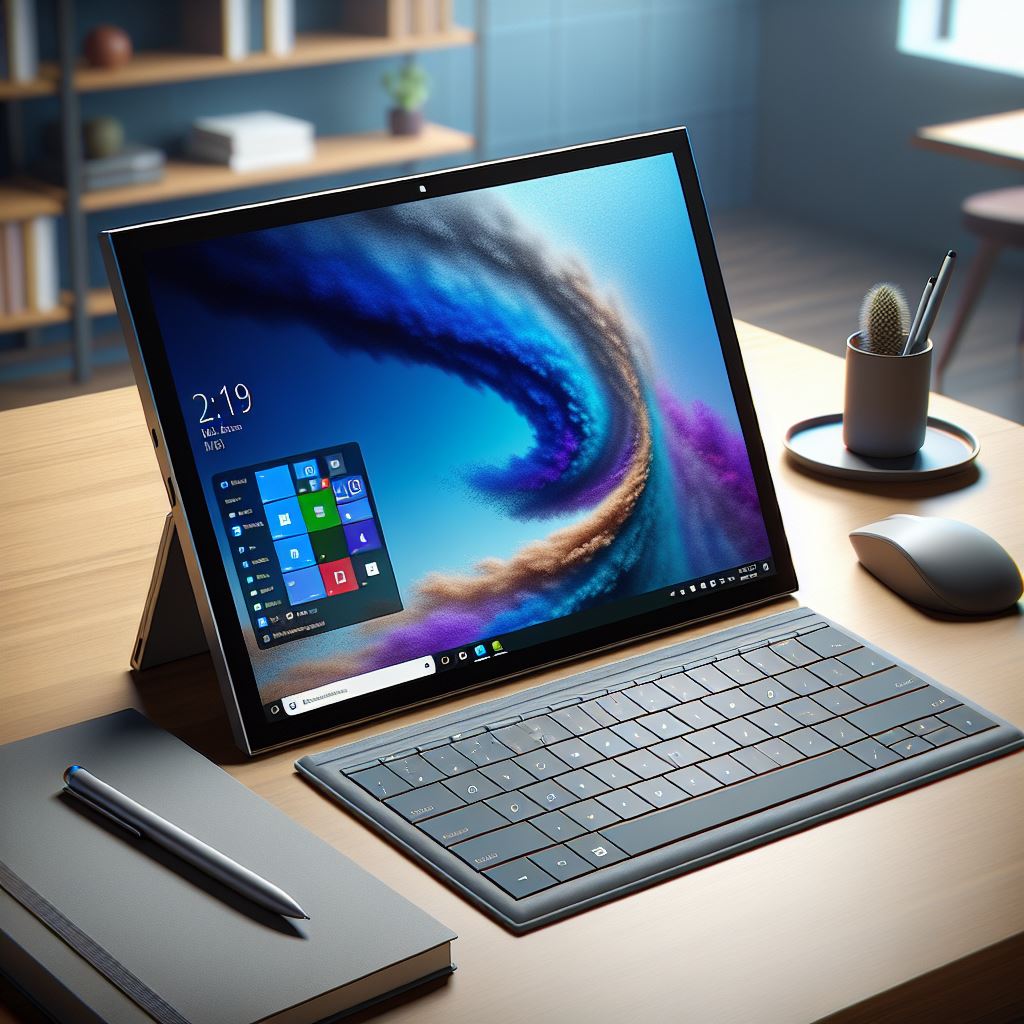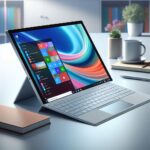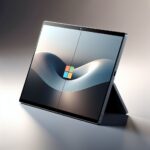Surface Pro X (SQ2): A Look Back at an Ultra-Slim Windows on ARM Pioneer
The “Surface Pro X” line, which was Microsoft’s premium Windows on ARM tablet, has effectively been integrated into the main “Surface Pro” lineup by 2025.
Okay, let’s take a quick look at the Microsoft Surface Pro X from the perspective of a buyer in May 2025. This device was an innovative step for Windows on ARM, and understanding its place in today’s tech landscape is key if you’re considering one.
The Microsoft Surface Pro X, particularly the version equipped with the SQ2 processor, first arrived in late 2020. It was Microsoft’s continued vision for an ultra-thin, always-connected Windows experience, powered by ARM architecture for impressive portability and battery life.
As of May 2025, this device is roughly 4.5 years old. While its design remains strikingly modern, its internal technology and performance need to be evaluated against current standards.
- Ultimate Portability: Incredibly thin and light (starting at 1.7 lbs / 774g), it was designed for maximum mobility.
- Always-Connected Experience: With optional Gigabit LTE, it aimed to keep you productive wherever you had a cellular signal.
- Sleek Surface Design: Premium materials, a built-in kickstand, and a vibrant PixelSense display were hallmarks.
- ARM Efficiency: The promise of good battery life thanks to the ARM-based Microsoft SQ2 chip.
Key Specifications Revisited (for 2025 Context):
Let’s break down the specs you’ve listed, keeping our 2025 viewpoint:
- Cost: The “Starting from $899” was closer to its original retail price. In 2025, you’d primarily find the Surface Pro X (SQ2) on the used or refurbished market at significantly lower prices. Expect prices to vary widely based on condition, storage, and included accessories, likely in the $250 – $450 range if you can find it.
- CPU: Microsoft SQ2 (8 cores, up to 3.15 GHz). This custom chip, co-developed with Qualcomm, is based on the Snapdragon 8cx Gen 2.
- GPU: Microsoft SQ2 Adreno 690.
- RAM: Typically came with 8GB or 16GB of LPDDR4x RAM. (16GB is preferable for better multitasking).
- Display: A beautiful 13-inch PixelSense touchscreen with a sharp 2880 x 1920 (267 PPI) resolution. This display still holds up well in terms of clarity and touch responsiveness.
- Storage: SSD options were 128GB, 256GB, or 512GB. The SSD is upgradeable, which is a plus.
- Battery Life: Originally claimed “up to 15 hours.” In 2025, for a used device, expect significantly less due to battery degradation. If you find a new-old-stock unit, the battery will still have aged. Realistically, 5-8 hours for light to moderate use would be a more practical expectation.
- Connections:
- Wi-Fi 6: Still a decent standard, though new devices in 2025 feature Wi-Fi 6E or Wi-Fi 7.
- Optional Gigabit LTE: This remains a strong point for on-the-go connectivity.
- Two USB-C ports (USB 3.2 Gen 2, up to 10 Gbps): Functional, but lack the Thunderbolt or USB4 speeds and versatility found on many 2025 laptops.
- 1 x Surface Connect port (for charging and docking).
- 1 x Surface Keyboard connector.
- Design: Ultra-thin and lightweight (starting at 1.7 lbs / 774 g) with a built-in kickstand and premium magnesium alloy construction. Available in Matte Black and Platinum. The design is arguably timeless and still looks very sleek.
- Operating System: Comes with a Windows 11 license. Windows 11 on ARM has matured since 2020, with better x86 (and some x64) app emulation.
- Additional Features:
- Windows Hello facial recognition (still excellent for quick logins).
- Dual far-field studio mics.
- Support for the Surface Slim Pen (often sold separately).
- Included Accessories (Typically):
- Power Supply: Yes.
- Surface Pen: Sometimes included in specific bundles when new; less likely in used sales unless specified.
- Type Cover (Keyboard): Almost always sold separately. This is essential for laptop-like productivity.
Performance & App Compatibility in 2025: Setting Realistic Expectations
This is where the Surface Pro X (SQ2)’s age is most apparent:
- SQ2 Processor Performance: By 2025 standards, the SQ2 chip will feel sluggish for anything beyond basic tasks. Web Browse with a moderate number of tabs, email, word processing, and media consumption will generally be okay, especially with ARM-native apps (like Microsoft Edge and Office). However, it will struggle with:
- Demanding applications.
- Heavy multitasking.
- Most modern games.
- Resource-intensive creative work (video editing, complex photo editing).
- Windows on ARM & App Compatibility:
- Native ARM64 Apps: The ecosystem of apps compiled specifically for Windows on ARM has grown since 2020. These will offer the best performance and efficiency on the SQ2.
- x86 Emulation: Windows 11 on ARM can emulate 32-bit and 64-bit x86 applications. While compatibility has improved, there’s a performance overhead. Simpler x86 apps might run adequately, but more complex or older x64 applications may run slowly or not at all.
- Drivers: Ensure any peripherals you plan to use have ARM64-compatible drivers.
Compared to modern ARM chips (like Qualcomm’s Snapdragon X Elite series found in 2024-2025 Windows laptops) or current Intel/AMD mobile processors, the SQ2 is significantly behind in raw power.
Why Consider a Surface Pro X (SQ2) in 2025?
Despite its age, there are a few scenarios where it might still make sense:
- Strict Budget for an Ultra-Portable LTE Device: If you find one for a very low price (e.g., under $300-$350 with keyboard) and your absolute priorities are extreme thinness, lightness, and built-in LTE for very light tasks like email and web Browse on the go.
- Secondary “Companion” Device: As a stylish secondary device for travel where performance isn’t critical, but portability and connectivity are.
- For Collectors or Tech Enthusiasts: As an example of an early premium Windows on ARM 2-in-1.
- If You Primarily Use ARM-Native Microsoft 365 Apps & Edge: For users whose workflow is almost entirely within the optimized Microsoft ecosystem for ARM, the experience will be better.
What to Watch Out For in 2025:
- Performance Bottlenecks: Don’t expect it to keep up with demanding tasks or heavy multitasking.
- Battery Health: On a used device, check battery wear. Replacement can be difficult.
- Limited Long-Term Software Support: While it runs Windows 11, it’s older hardware. Future major Windows feature updates might eventually phase out support, or performance could degrade with newer OS versions. Security updates should continue for a while longer.
- App Compatibility Quirks: Be prepared for some apps to run slowly under emulation or not at all.
- Accessory Costs: If the Type Cover or Slim Pen aren’t included, these can add significant cost.
Price & Availability in 2025:
As mentioned, the Surface Pro X (SQ2) is primarily found on the used and refurbished market (e.g., eBay, Amazon Refurbished, local marketplaces). The original $899+ price is not relevant. Prices should reflect its age and performance limitations.
Alternatives to Consider in 2025:
For a similar price to what the Pro X (SQ2) might cost now, or for a bit more, you could find:
- Newer Windows on ARM Laptops (2024-2025 models): Devices powered by Qualcomm Snapdragon X Elite or X Plus chips offer a night-and-day performance difference, much better app compatibility, and modern features.
- Recent Budget Intel/AMD Windows Laptops or 2-in-1s: These will likely offer better raw performance and broader app compatibility than the SQ2.
- Older Flagship x86 Surface Pro Models (e.g., Surface Pro 7+/8 used/refurbished): These would offer better x86 performance if ARM isn’t a specific draw.
- Chromebooks or Android Tablets with Keyboards: For very light tasks and portability, these can be cost-effective alternatives.
Verdict: A Niche Purchase for Specific Needs in 2025
The Surface Pro X (SQ2) was a beautifully designed and forward-thinking device for its time. In 2025, its sleek aesthetics and excellent portability still impress. However, its processing power and ARM architecture (from that generation) mean it’s best suited for a niche audience with modest performance expectations who prioritize its slim form factor and LTE connectivity above all else, and can acquire it at a very compelling low price.
For most users in 2025, newer devices—either ARM-based or x86—will offer a significantly better and more future-proof experience, even if they come at a slightly higher cost than a used Pro X (SQ2). If you do consider it, go in with clear eyes about its capabilities in today’s tech world.



